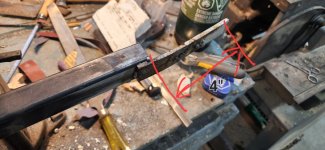For context I had an late night yesterday in the shop tinkering away. An old 12 gauge Kessler bolt gun was picked as the next project gun in line to practice on (rust bluing, refinishing the stock, cut it for chokes etc.) I want to put a scope base on it and make it a budget deer and turkey gun project for fun and experience.
I have blank rail stock and bases that could be machined and fitted. But it needs to be a barrel mounted rail or base set for an LER scope due to receiver design constrictions, so I'll have to tin the barrel and the base and sweat them together. Doesn't sound that bad, except all my rail stock and bases are aluminium...
I'd just buy steel rail, but now I'm determined to find a way to bond the dissimilar metals by using specialty solder and test it's durability. wether it goes good or bad I still gain experience and maybe even a new ability. I did some research into muggy weld super alloy #1, it has a great track record boasting that it has 20 000psi bond strength and can solder aluminium to stainless, brass, mild steel, high carbon steel etc. it's melting point is 350°f so within 10°f of 60/40 tin solders melting temp. So it should be able to take the max barrel temp of a bolt action 12 gauge
Has anyone here tested it or worked with it to sweat on a aluminium base to a barrel? Or even just messed around with it or other products bonding steel and aluminium in any capacity? Is there any other products or methods that I'm unaware of for this soldering experiment? Thanks in advance for your insight
I have blank rail stock and bases that could be machined and fitted. But it needs to be a barrel mounted rail or base set for an LER scope due to receiver design constrictions, so I'll have to tin the barrel and the base and sweat them together. Doesn't sound that bad, except all my rail stock and bases are aluminium...
I'd just buy steel rail, but now I'm determined to find a way to bond the dissimilar metals by using specialty solder and test it's durability. wether it goes good or bad I still gain experience and maybe even a new ability. I did some research into muggy weld super alloy #1, it has a great track record boasting that it has 20 000psi bond strength and can solder aluminium to stainless, brass, mild steel, high carbon steel etc. it's melting point is 350°f so within 10°f of 60/40 tin solders melting temp. So it should be able to take the max barrel temp of a bolt action 12 gauge
Has anyone here tested it or worked with it to sweat on a aluminium base to a barrel? Or even just messed around with it or other products bonding steel and aluminium in any capacity? Is there any other products or methods that I'm unaware of for this soldering experiment? Thanks in advance for your insight







































































